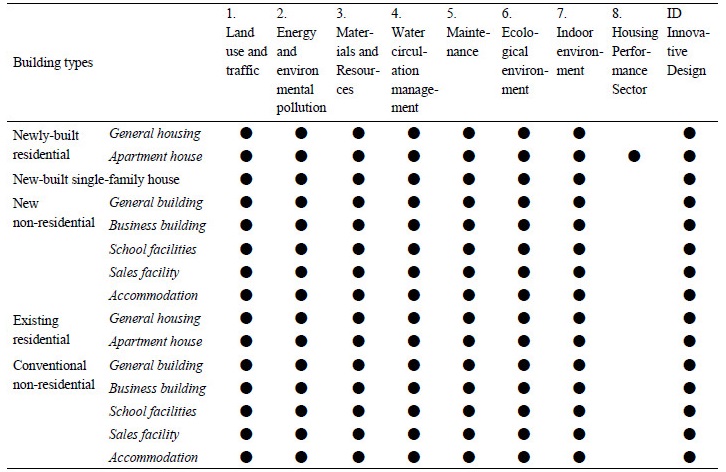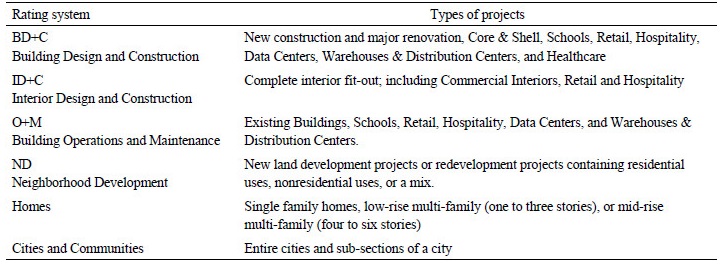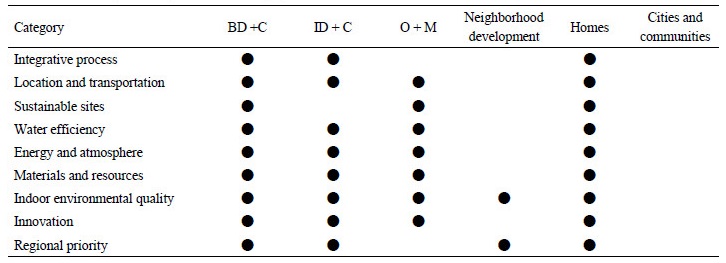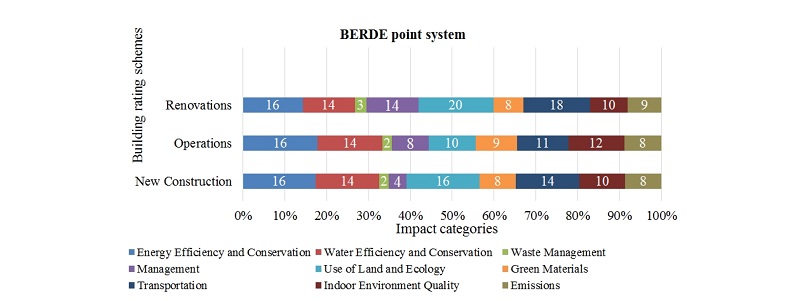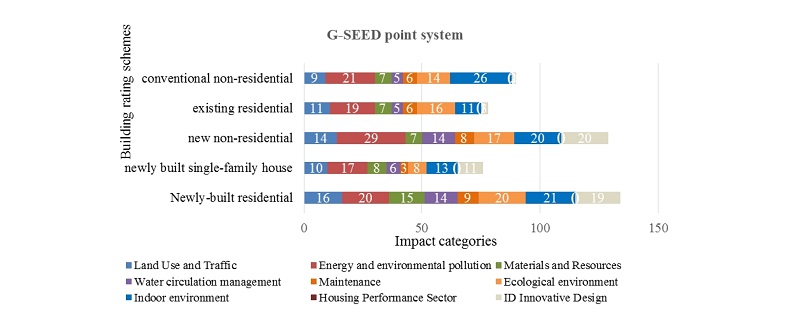Introduction
Methodology
The Philippine Green Building Rating System, BERDE
The Korean Green Building Rating System, G-SEED
U.S. Green Building Rating System, LEED
Discussion
Conclusion
Introduction
Many countries and institutes have been exerting efforts to create policies, and seek ways to minimize or possibly eliminate the detrimental effects of structural developments and contribute to environmental enhancement and protection. Since the Rio Declaration’s publication that the environment where we live, and development that we all do in attempting to improve our lot within that abode, are inseparable [1]; policies, organizations, and tech-nologies emerged to tackle issues. For example, 88 countries have submitted their nationally determined contri-butions to the Paris Agreement, representing 56% of global emissions; as a result; 45 national and 25 subnational jurisdictions are putting price carbon emissions [2]. Also, Turner’s 2014 Green Building Market Barometer shows that interest in Green Globes and other alternative building rating systems is up 250% in two years [3].
The World Commission on Environment and Development’s report [4] explained that the earth “is dominated not by human activity and edifice but by nature such as a pattern of clouds, oceans, greenery, and soils; and humanity’s inability to fit its activities into the nature’s pattern causes changing planetary systems”. In line to this, the United Nations Conference on Sustainable Development (Rio+20), held in Rio de Janeiro in June 2012 set up sustainable development goals, which could be useful tools in achieving sustainable development [5].
Green building rating systems are one of the tools useful in achieving sustainable development. Green building standards, certifications, and rating systems aimed mitigating the impact of buildings on the natural environment through sustainable design [6]. According to the U.S. Green building Council [7], buildings account for an average of 41% of the world’s energy use, responsible for 38% of all CO2 emissions, use 13.6% of potable water, use 40% of the world’s raw materials, and tons of waste. Similarly, other countries South Korea [8] reports that buildings account for one third of energy consumption, 40% of resource consumption, 50% of CO2 emissions and 20% to 50% of waste emissions. Acknowledging these facts, different countries create their own green building rating systems for responsible building and to evaluate sustainable development in understandable and transparent way. The aim of this study is to analyse the Philippine green building rating system BERDE in comparison with Korea and U.S rating system to seek better green rating practice for understandability and transparency.
Methodology
BERDE was compared and contrasted to the Korean G-SEED and American LEED. For the purpose of this study, the methodology is done in two parts. First, the three green building rating systems were reviewed in terms of their impact categories, building types, and rating levels. Second, their point system and evaluation methods were analysed. The similarities and differences of the three green building rating systems were determined and possible recommendations for improvements of BERDE were suggested. Most of the data came from the websites of the three green building rating systems.
The Philippine Green Building Rating System, BERDE
The Building Ecological Responsive Design Excellence (BERDE) was established by the Philippine Green Building Council (PHILGBC) and recognized by the Philippine government, through the Department of Energy (DOE), as the National Voluntary Green Rating System of the country [9]. It was developed as an appropriate res-ponse to the Philippine building industry’s need to address the issue of climate change and to facilitate green pro-jects in the country. Moreover, BERDE is developed as a tool to assess, measure, monitor, and certify the perfor-mance of green building projects above and beyond existing national and local building and environmental laws, regulations, and mandatory standards. BERDE Green Building Rating Schemes are made freely available for buil-ding professionals to use in designing, constructing and operating building projects in a resource-efficient, econo-mically-viable, and socially-responsible manner. Table 1 summarizes the impact categories BERDE is assessing.
The BERDE-NC (new construction), BERDE-RN (retrofits and renovation), and BERDE-OP (operations) are applicable to commercial buildings, vertical residential buildings, clustered residential buildings, and educational buildings. Projects registered in any BERDE scheme will have the following final ratings in Table 2.
After the green project was approved for the BERDE registration, passed in stage 1 certification wherein all the documents required are assessed, and stage 2 certification which is on-site assessment, a 1-star to 5-star BERDE ratings will be awarded and recognized as BERDE certified as minimum practice, good practice, exemplar practice, world class, and world leader depending on the project’s total achieved points out of the 100 total points from the 9 impact categories.
The Korean Green Building Rating System, G-SEED
Green Standard for Energy and Environmental Design (G-SEED) is South Korea’s national voluntary green building rating system established under the Ministry of Land, Infrastructure, and Transportation (MOLIT) and Ministry of Environment (ME) as a rating tool for “green buildings” or “sustainable buildings” throughout their life cycle. G-SEED aims to achieve sustainable development, save energy, and reduce environmental pollution reduc-tion from the design, construction, use, end-of-life, to disposal of wastes from the demolition. G-SEED has been implemented since January 2002 and continuously being revised through researches to ensure being updated to the best possible practices and related laws. The 2016 G-SEED revision’s impact categories and building types being assessed are summarized in Table 3.
All of the building types are being assessed on the first 7 impact categories such as land use and traffic, energy and environmental pollution, materials and resources, water circulation management, maintenance, ecological environment, and indoor environment. It is only the newly-built residential under the category of apartment houses is assessed on the housing performance sector; however, no quantifying measurement is given to this category. Furthermore, ID innovative design category is a bonus point to a project that possess exemplar practices. G-SEED certification is being carried out by 10 designated certification authorities and award a Grade 1 to Grade 4 Green Building certificate according to the total achieved points from a building type category.
U.S. Green Building Rating System, LEED
Leadership in Energy and Environmental Design (LEED) is one of U.S. green building rating system devised by United States Green Building Council (USGBC) to evaluate the environmental performance of a building. It is not only used in the United States but also actively use in 160 countries around the world. One of its purposes is to encourage market transformation towards sustainable design. Many countries use LEED as a guide to create their own green building rating system. Its rating systems, sustainable targets, and building types being assessed are summarized in Table 4, and impact categories and rating systems in Table 5.
Neighborhood Development (ND) was engineered to inspire and help create better, more sustainable, well-connected neighborhoods; thus, it considers Smart location and linkage, neighborhood pattern and design, green infrastructure and buildings, innovation and design process, regional priority credit. Cities and Communities category uses Arc that calculates a performance score out of 100 based on a global data set and action-oriented strategies across five categories – energy water, waste, transportation, and human experience [10].
Based on the total points achieved, a project is awarded one of the LEED rating levels: Certified (40-49 points), Silver (50-59 points), Gold (60-79 points), and Platinum (80+ points).
Discussion
Each of the green building rating systems’ assessment method and point systems are plotted and discussed in the following figures.
Figure 1 explains the evaluation method and point system of BERDE. Each building rating scheme evaluates all the impact categories but designate not necessarily the same scores. Each category impact is scored according to its weight contribution to the environmental issues of the country. Energy Efficiency and Conservation, and Water Efficiency and Conservation were held in constant value in all rating schemes. In Renovations, Use of Land and Ecology have the highest score (20%). In Operations, Energy Efficiency and Conservation gets the highest score (16%). In New Construction, Energy Efficiency and Conservation, and Use of Land and Ecology get the highest score (16%). Emissions and Green Materials have closely similar weight in all the rating schemes (8-9%).
Figure 2 describes the assessment method and point system of G-SEED. Energy and Environmental Pollution has the highest weight consistently in the all the rating schemes except in Newly-built Residential, and Conventional non-residential wherein Indoor Environment gets the highest point. Indoor Environment has the second place in all the rating systems except in Newly-built Residential which considers Ecological Environment and Energy and Environmental Pollution as second priority; and Existing Residential which takes Ecological Environment. Innovative Design is set also as second highest priority in New-non Residential, and 3rd in Newly-built residential.
Figure 3 showed that Energy and Atmosphere weighs the heaviest point (33-38%) consistently in all rating schemes in LEED evaluation. However, each rating scheme values the 2nd priority differently. Building Design and Construction scores Location and Transportation, and Indoor Environmental Quality as second. Interior Design and Construction sets Location and Transportation as second. While Building Operations and Maintenance, and Homes set Indoor Environmental Quality as second. Regional Priority and Innovation are scored constant for all the rating schemes.
Conclusion
BERDE, G-SEED, and LEED are all unique in their assessment methodology as well as emphasis; however, they share common purpose that is to lessen the negative effects of buildings such emissions of greenhouse gas through energy consumption. This study has the following key findings:
First, all the three green building rating systems put heavy weight on Energy Efficiency; this is supported by the report that 70% of the buildings reduced their energy consumption [11] using green building design. Furthermore, it explains that most GHG comes from the consumption of energy in the building’s life cycle.
Second, both G-SEED and LEED placed Indoor Environment Quality as second priority while BERDE put Water Efficiency and Conservation as second. This result explains the priority of the rating systems which is may be influenced by the building types and climate. Philippines is a tropical country that no heating equipment is needed and natural ventilation is encouraged; whereas South Korea and U.S. have winter that require insulation, and heating and air conditioning. Also, both South Korea and U.S. are developed countries and highly industrial countries; thus jobs are usually indoors (such as offices, factories, and others). A study conducted estimated that Americans spend 87% of their time indoors [12], which is similarly the scenario of South Korea.
Third, BERDE evaluates Emissions, and Waste Management; whereas, both LEED and G-SEED don’t. This explains that G-SEED and LEED has integrated the Emissions and Waste Management in other categories possibly in Materials and Resources as both use life cycle assessment LCA. LCA is under Materials option in LEED v4 whilst G-SEED has LCA in its Innovative Design option.
Finally, both LEED and G-SEED have Innovation category but BERDE doesn’t have. Innovative Design encourages the building designers to consider the best latest design through in-depth researches. Further study on the possible reclassification of BERDE categories can help a more concise and clear quantification of environmental impacts of the buildings.





